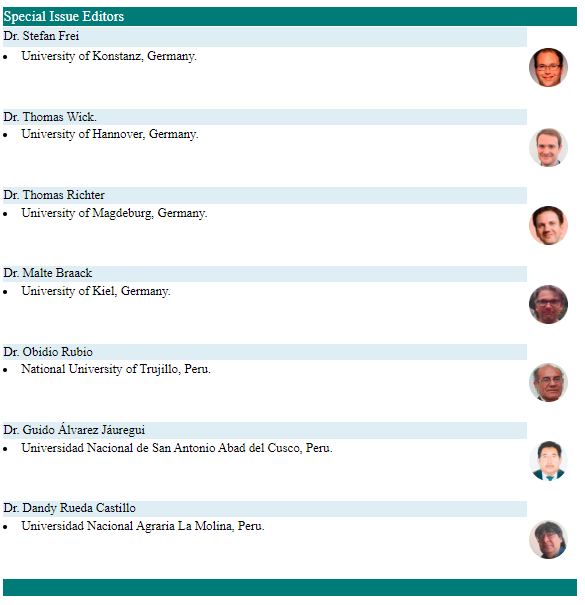Mathematical modeling of injury healing process under the action of an active pharmaceutical ingredient (API)
DOI:
https://doi.org/10.17268/sel.mat.2019.02.14Palavras-chave:
Injury, healing, mathematical modelling, pharmaceutically active principle, mechanismResumo
In this work we carried out the mathematical modeling of the wound healing process, which is a well documented topic in medical and biological practice; but mathematically speaking there are still too much to be done for a clear understanding of the healing phenomom. Here we contribute to the mathematical modelling by using chemical kinetic concepts and mathematical tools, from which we have been able to formulate a system of ordinary differential equations of initial value, whose solution is presented graphically in front of a case study, where we have tested an active pharmaceutical principle with respect to its effectiveness. Finally, the speed of the healing process for such a case study produced an excellent agreement with experimental data that has been omitted due to confidentiality.Referências
A. C. de O. G. et Al., Wound healing: Literature Review. 1995; 43(3):221–223.
Dokoumetzidis, A. and Macheras, P. A century of dissolution research: From Noyes and Whitney to the Biopharmaceutics Classification System. Int. J. Pharm. 2006; 321(1–2):1–11.
Eming, S. A., Martin, P. and Tomic-Canic, M. Wound Repair and Regeneration Mechanisms. Sci. TransL Med, 2014; 322(265):265sr6.
Flegg,J. A., Menon, S. N., Maini, P. K. and McElwain, D. L. S. On the mathematical modeling of wound healing angiogenesis in skin as a reaction-transport process Front. Physiol. 2015; 6(SEP):1–17.
Flynn, B. M. E. and Rovee,D. T. Healing Mechanisms. 2015; 82(10):1544–1549.
Geris, L., Gerisch, A., and Schugart, R. C. Mathematical Modeling in Wound Healing, Bone Regeneration and Tissue Engineering. Acta Biotheor., 2010; 58(4):355–367.
Kratz, G. Modeling of wound healing processes in human skin using tissue culture Microsc. Res. Tech. 1998; 42(5):345–350.
Leitao, F., Leitao, S. G., da Fonseca-Kruel, V. S., Silva, I. M. and Martins, K. Medicinal plants traded in the open-air markets in the State of Rio de Janeiro, Brazil: An overview on their botanical diversity and toxicological potential. Brazilian J. Pharmacogn. 2014; 24(2):225–247.
Madhumathi, K. et al., Development of novel chitin/nanosilver composite scaffolds for wound dressing applications. J. Mater. Sci. Mater. Med. 2010; 21(2):807–813.
Palomino-Infante, A. R. Modelling the dynamics of the pulsed isolation of essential oils. in IX Americas Conference on Diferential Equations, 2012; 30–35.
Palomino-Infante, A. R. Pulsed Isolation of Essential Oils Using Pulsed Steam. Ph.D. Thesis, FQIQ, UNMSM. 2016.
Peppas, N. A. and Langer, R. Origins and development of biomedical engineering within chemical engineering. Biomed. Res., 2004; 50:536–546.
Zhang,N., Yan, H. and Wen, X. Tissue-engineering approaches for axonal guidance. Brain Res. Rev., 2005; 49(1):48–64.
Downloads
Publicado
Como Citar
Edição
Seção
Licença
Os autores que publicam nesta revista aceitam as seguintes condições:
Os autores mantêm os direitos autorais e atribuem à revista o direito da primeira publicação, com o trabalho registrado com a licença de atribuição Creative Commons Atribución 4.0 Internacional (CC BY 4.0), que permite que terceiros usem o material publicado sempre que mencionarem a autoria do trabalho e os direitos autorais. Primeira publicação nesta revista.
Os autores podem fazer outros acordos contratuais independentes e adicionais para a distribuição não exclusiva da versão do artigo publicada nesta revista (por exemplo, incluí-la em um repositório institucional ou publicá-la em um livro), desde que afirme claramente que o trabalho Foi publicado nesta revista.
É permitido e recomendado aos autores que publiquem seus trabalhos na Internet (por exemplo, em páginas institucionais ou pessoais) antes e durante o processo de revisão e publicação, pois isso pode levar a trocas produtivas e a uma disseminação maior e mais rápida do trabalho. publicado (Consultar: efeito do acesso aberto).












